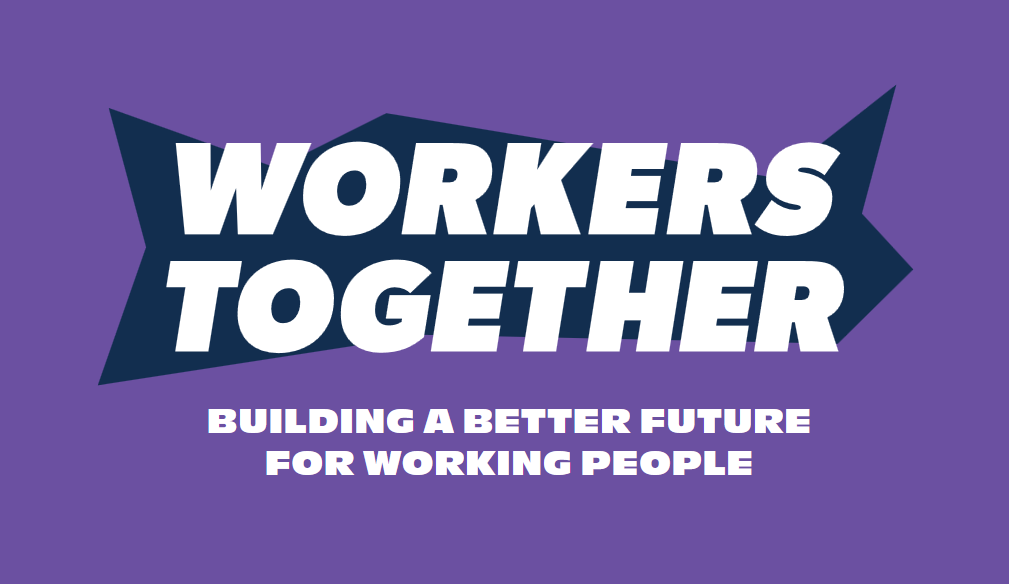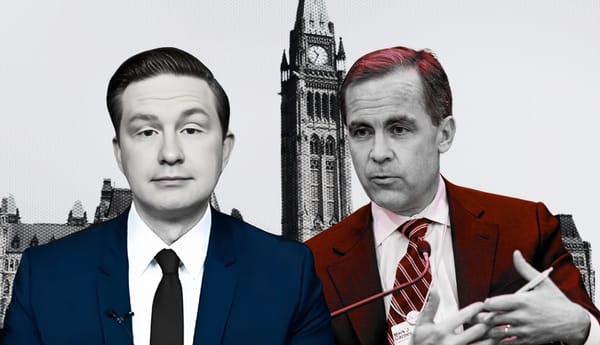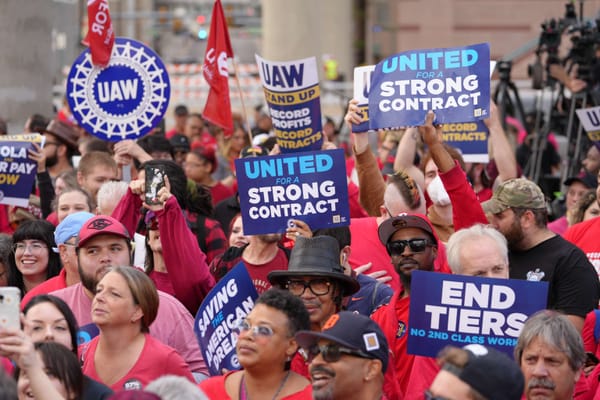We are in the midst of a significant reorientation of domestic industrial policy in North America. Following the COVID-19 pandemic, governments around the world publicly recognized that global supply chains rendered many countries vulnerable to shortages and shocks to international systems of production, shipping and finance. In response, both the American and Canadian governments have begun to commit sizable public investments to domestic manufacturing, emphasizing state intervention in a way that was largely eschewed throughout the period of neoliberal triumphalism.
Many progressives and unions are understandably pleased by the return of state intervention and public investment, even if the latter is largely coming in the forms of subsidies, tax credits and various private-public investment schemes. However, the industrial policy reorientations emanating from the both Biden and Trudeau governments have been intimately tied to a hawkish posture toward China and other ‘official enemies.’ This is a troubling development and should worry labour and the left.
From Neoliberalism To Post-COVID Industrial Policy?
Neoliberal governments long ago largely abandoned “industrial policy” — the idea that states should use spending and various policy levers to guide the direction of private and public investment to meet socially-defined long-term objectives — in favour of letting the private sector (i.e., capital) make these determinations. State and corporate power instead combined to promote free-trade and capital mobility through the deregulation of finance and investment. A global infrastructure of free-trade agreements and financial instruments allowed corporations to off-shore huge swathes of domestic production, which in part led to the increasingly complex and brittle global supply chains that snapped in 2020 and 2021.
After the political fallout from the pandemic, an opportunity opened to put support for domestic production back on the agenda, and to include protections for labour as part of the package. Some left political economists have long called for the return of industrial policy, particularly in light of the threats posed by climate change and the pressing need for a just transition. Only public investment, planning and state direction are up to the task of addressing the dire circumstances we face, this argument correctly contends.
Three critical pieces of U.S. legislation, the Infrastructure Investment and Jobs Act ($550 billion), the CHIPS and Science Act ($280 billion), and the Inflation Reduction Act ($394 billion), are now set to pour huge investments into critical infrastructure, high-tech manufacturing, and green energy. In Canada, the federal government has used the 2023 budget to introduce its response to this American reinvestment strategy, as was expected.
Yet, these green and high-tech investments have also consistently been framed as responding to the “threat” posed by China. Indeed, the CHIPS Act in particular is as much a “national security” policy as it is an industrial policy plan. For example, the U.S. Secretary of Commerce, Gina Raimondo, referred to the Biden administration’s investment in American microchip manufacturing as “a once-in-a-lifetime opportunity, a once-in-a-generation opportunity, to secure our national security and revitalize American manufacturing and revitalize American innovation and research and development.” On the climate front, using public subsidies to “crowd in” private investment in North America is also meant to “take aim” at China’s dominant place in the green energy supply chain.
Alongside new spending commitments have also been a series of moves to limit and control China’s access to critical technologies and inputs. Last October, the U.S. Bureau of Industry and Security (BIS) introduced a series of regulatory controls, blocking Chinese firms from both purchasing and producing microchips. The BIS’ new rules further indicate that any other governments that “prevent BIS from making compliance determinations” will similarly have their access to U.S.-made technologies restricted.
Reinvigorating domestic industry, addressing the climate crisis and aiding the American workforce are lofty goals, but are apparently only politically salable as part of the foreign policy objective of containing official state enemies.
Hitching Our Wagon To The Wrong Horse
There are many political problems with tying a renewed industrial policy to “national security” and a potential new Cold War with China.
For starters, when domestic social goals are subordinated to foreign policy objectives, it’s exceedingly more difficult to ensure industrial policy is worker-friendly and doesn’t exacerbate economic inequalities. The CHIPS Act, as one particular example, is replete with shortcomings.
Two years ago, as the pandemic raged, shortages of semiconductors caused huge price increases for cars and appliances and sent ripple effects throughout various supply chains. Governments and consumers alike suddenly realized how dependent we’d become on the production and ready supply of microchips. As a piece in its much larger “supply-side” reinvestment strategy, the Biden administration and Democrats in Congress responded to the semiconductor shortage with their massive stimulus bill directed toward domestic chips production (this after decades of allowing and encouraging such firms to outsource).
In most cases, public money will now flow to hugely profitable and powerful corporations. When the legislation was being debated, Senator Bernie Sanders tried to insert modest restrictions on executive compensation and share buybacks into the CHIPS Act. These were roundly voted down. The exigencies of passing the bill outweighed trivial considerations, such as limiting the ability of rich CEOs to receive ever-larger compensation packages while benefiting from public subsidies, apparently.
Now, according to reporting in the Financial Times, the chips industry is facing profit woes, falling prices and a huge drop in demand brought on by higher interest rates and suppressed consumer spending. How quickly capital can go from shortage to glut. What this portends for the future job prospects in domestic semiconductor production is an open question.
Handing out public subsidies to corporations with few strings attached is far from the only issue with the new industrial policy. A more aggressive posture toward China risks escalating an already fraught geopolitical situation. To the degree that labour willingly signs on to a politics of military posturing and escalation, it risks further undermining any prospect of solidarity between workers across borders. Workers are already encouraged to think of themselves as in competition with others in less developed countries. The last thing they need is to hear union and progressive leaders promote similar thinking.
Furthermore, tying industrial policy to a new Cold War is likely to run counter to workers’ material interests in the long-term. Admittedly, investment packages like the U.S. Inflation Reduction Act will encourage green investment and may also promote good, union goods. But escalating tensions with China and other countries will only encourage the diversion of greater portions of national GDP toward military spending down the road.
Undoubtedly, certain workers’ jobs are tied to military and other anti-social investment. We must acknowledge this and propose just solutions to redeploy such workers in peaceful industries. But on the whole, and in the here and now, the vast majority of workers have no material interest in escalating foreign policy tensions. Spending on war and war-related production will come at the direct cost of social investment in healthcare, education, and other social provisioning, including investment for a green and just transition.
Last, it’s less than clear that coupling public investment and industrial policy with hawkishness toward China and other adversaries is a winning political strategy. On this point, principle and pragmatism meet. On moral grounds, I would argue that the left shouldn’t pursue policies, foreign or domestic, that inflame geopolitical tensions around the world. Doing so almost always redounds to the benefit of elites, in one’s own country and abroad.
But one doesn’t have to fully accept this normative position to see that encouraging a left-wing version of “nationalist populism” is bad politics, electorally and otherwise. The recent scandal over accusations of “dual loyalty” leveled at MP Han Dong demonstrates the troubling directions to which this toxic politics ultimately leads. You don’t need to support the Liberal Party to see this.
A recent example from the United States is even more instructive. Justin H. Vassallo, writing at the New Left Review’s Sidecar blog in the aftermath of the U.S. midterm elections, deconstructs the loss of now-former Democratic House Representative Tim Ryan in Ohio. Ryan, a Democratic member of the House since 2003, lost his bid for a senate seat to the Peter Thiel-backed MAGA-memoirist J. D. Vance. Ryan had, as Vassallo puts it, “spent the majority of his political career in the ideological wilderness,” a “pro-labour protectionist” who sought to maintain the party’s links with the region’s declining industrial workforce. Yet, in his 2022 campaign, Ryan doubled down on a hyper-nationalist approach to industrial policy, characterized principally by hawkishness toward China. “China’s winning. Workers are losing,” Ryan declared in an early campaign ad, surmising that re-establishing American manufacturing dominance came down to a contest between “capitalism and communism.”
As Vassallo concludes, “It is hard to see what, if any, advantage may have been gained from reframing his pro-labor protectionism in Cold War terms of national security. In the end, the attempt to outflank Vance as a vociferous trade hawk merely conceded the terrain on which the campaign would be fought.”
Vassallo’s latter point is key. By rebranding his long-time policy programme with ‘anti-China’ messaging, Ryan effectively ceded the rhetorical and political ground to the right-winger, Vance. National security, hawkishness, xenophobia — these are and have always been the terrain of the revanchist right-wing. The difference between pseudo-libertarian Sinophobia and labour-protectionist Sinophobia likely proved indistinguishable to the majority of Ohio voters. The right-wing will always be more convincing national xenophobes, thankfully.
As my colleague Chris Fairweather recently argued, growing support for right populist politicians among union members is, in many respects, a result of labour strategies that have deployed nationalist rhetoric in pursuit of ostensibly progressive goals. Campaigns to “buy Canadian” or resist out-sourcing, by trading in nationalism and at times problematic characterizations of foreign competition, leave workers susceptible to the appeals of right-wing politicians and parties. Fairweather rightly asks, “How can unions frame their work as being primarily about defending Canadian interests without leaving their members vulnerable to appeals by populists about what those interests look like and how to advance them?” It’s a difficult needle to thread.
In some respects, there’s nothing ‘new’ about the new industrial policy’s connection to an aggressive posture toward foreign adversaries. The postwar Keynesian policy program was also deeply intertwined with the first Cold War and its military industrial complex, including massive state subsidies to direct research, development and investment. In this sense, perhaps we shouldn’t be terribly surprised that contemporary “re-shoring” and a renewed industrial policy are coterminous with a combative posture toward China and the latter’s growing international influence.
But we should know better now. Affixing a progressive industrial program to a bellicose foreign policy won’t promote working-class interests, much less advance the electoral prospects of the left in the future.







